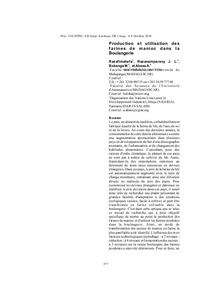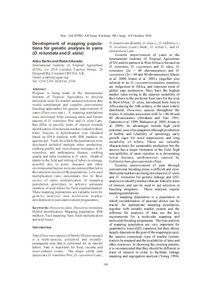Welcome to the International Institute of Tropical Agriculture Research Repository
Conference Documents: Recent submissions
Now showing items 421-440 of 727
-
Competitiveness of cassava-based ethanol production in Southern Africa: a case of Angola, Malawi, Mozambique, South Africa and Zambia
(International Institute of Tropical Agriculture, 2010)Whereas the global economy has from time immemorial depended on fossil fuels, technological innovations are steadily paving ways to relieve pressure from the dwindling resources and combat the environmental consequences that come along with oil extraction and use. Production and use of bio-fuels such as ethanol and bio-diesel are among such innovations that are attracting attention both in developed and developing economies. Although Africa is the largest producer of cassava on the globe, the ... -
Optimal units of selection – how many plants are representative of diversity in collections of cowpea landrace accessions?
(International Institute of Tropical Agriculture, 2010)The International Institute of Tropical Agriculture houses the largest collection of cowpea landraces in the world. This collection has been studied using agro morphological, botanical and geographic descriptors to define a core collection with a smaller reference collection being defined thereafter using molecular markers. Within any collection of germplasm it is important to understand the level of inbreeding and heterogeneity as these have direct impact on germplasm maintenance strategies and ... -
Sharing of responsibilities of cowpea and wild relative long term conservation
(International Institute of Tropical Agriculture, 2010-10) -
Ex-ante evaluation of cassava research for development in Malawi: a farm household and random utility modeling approach
(African Association of Agricultural Economics, 2010)Ex ante evaluation of agricultural research for development projects has become important in recent years for priority setting, ex post impact assessment and learning about generalizability to other populations and contexts. We apply farm household and random utility modeling to baseline survey data and evaluate the impact of a cassava research for development project in Malawi prior to its implementation. The project is being implemented to unlock the potential of cassava in response to the ... -
Opening remarks and workshop objectives
(International Institute of Tropical Agriculture, 2010-01) -
Panama disease: recognition, impact and control methods
(International Institute of Tropical Agriculture, 2010) -
IPDN –West Africa review of progress in phase 1
(International Plant Diagnostic Network, 2010) -
Preliminary report on the status and host plant utilization by the Black Coffee Twig Borer, Xylosandrus compactus (Eichhoff) (Coleoptera: Curculionidae) in Uganda
(Association for Science and Information on Coffee, 2012-11)The Black Coffee Twig Borer, Xyalosandrus compactus (Eichhoff) is a new but rapidly spreading pest of coffee and other plant species. However, knowledge of its pest status, damage and host plant species utilization in Uganda is still limited. To ascertain its spread and impact, a survey was conducted on 250 farms in 25 districts in the 5 major coffee growing regions of Uganda. At farm level, 12 coffee trees were randomly sampled along a diagonal transect and assessed for X. compactus infestation. ... -
IPM-omics: from genomics to extension for integrated pest management of cowpea
(International Institute of Tropical Agriculture, 2012)Insect pests often develop resistance to insecticides, and such resistance represents a serious management problem. Devising methods that concurrently delay resistance and minimize injury by insects to field crops and stored grain has long been a goal of Integrated Pest Management (IPM). A centerpiece of IPM has been the combined use of biological control agents and prudent application of chemical insecticides. Unfortunately, successful application of IPM has remained a challenge. This chapter ... -
Biological control: a major component for the longterm cowpea pest management strategy
(International Institute of Tropical Agriculture, 2012)Current strategies to control insect pest problems in cowpea include, on the preventive side, host plant resistance and conservation biological control. Because very often these management options alone cannot provide adequate control, curative measures need to be taken, which include augmentative and inundative biological control, the application of biopesticides, and the judicious use of synthetic pesticides. Using synthetic pesticides as the first line of defense against insect pests is not ... -
Out scaling of improved cassava processing technology - Uganda lessons
(International Society For Tropical Root Crops-Africa Branch, 2012-02)Cassava (Manihot esculenta Crantz) has an immediate potential for use in food and feed industry in East and Central Africa (ECA). However, its industrial utilization in the region remains low, partly due to lack of improved processing technologies, lack of awareness of the alternative uses of cassava and technical know how for commercialization. To tap the potential of cassava in feed industry of Uganda, EARRNET and its partners, NARO, Ugachick and farmers, established in 2005 two pilot processing ... -
Lessonslearntand perspectives from a global effort to support the deployment of underutilized species, with special reference to documentation of knowledge and information
(Bioversity International, 2012)This paper focuses on the role of the Global Facilitation Unit for Underutilized Species in the promotion and facilitation of the sustainable deployment of underutilized plant species to increase the security of food and nutrition and alleviate poverty among poor rural and urban communities. -
Production et utilisation des farines de manioc dans la Boulangerie
(ISTRC-AB, 2012-02)Le pain, un aliment de tradition, est habituellement fabriqué à partir de la farine de blé, de l'eau, du sel et de la levure. Au cours des dernières années, la consommation de cette denrée alimentaire a connu une augmentation spectaculaire dans plusieurs pays en développement du fait d'une démographie montante, de l'urbanisation et du changement des habitudes alimentaires. Cependant, pour des raisons d'ordre climatique, la plupart de ces pays ne sont pas à même de cultiver du blé. Aussi, dépendent-ils ... -
Development des moyens de lutte contre le « Shimbu », cas de la culture du manioc au kasai oriental/RDC: Revue et contribution sur les moyens de lutte contre le complexe parasitaire shimbu
(International Society For Tropical Root Crops-Africa Branch, 2012-02)L'interaction des plusieurs contraintes, à savoir les maladies et ravageurs du manioc, les pratiques culturales inadéquates, la faible fertilité des sols, etc. contribuent à la baisse de la productivité du manioc. Il a été constaté à Luputa et Ngandajika que les champs des agriculteurs y compris les champs de manioc sont souvent infestés par un complexe maladie/ravageur localement appelée « shimbu ». Cette revue a pour objectif l'inventaire des connaissances et des différents moyens de lutte existants ... -
Using steam to dry food: introducing the (UPoCA) dryer
(International Association of Hydrological Sciences, 2012-02)The production of cassava flour involves drying grated and pressed cassava into pellets that are milled into flour. The drying process is one of the major bottlenecks to expanding the economic value of the crop. The industry looks for fast drying systems with high flour production capacity to meet market demands. Traditional sun-drying is limited by rainfall, and conventional drying systems are based on motorized machinery unsuitable for farm gate use. The UPoCA dryer has been developed to address ... -
Unleashing the power of cassava in Africa…are we there yet?
(International Society For Tropical Root Crops-Africa Branch, 2012-02)Cassava has long been expected to play a key role in rural economic growth in Africa, but has it happened yet? Although research partnerships have produced elite cassava varieties with 50% more yield potential and have demonstrated technologies to improve processing and increase marketing of cassava, the sub sector is constrained by low productivity and marketing difficulties. In DR Congo, Ghana, Malawi and Sierra Leone, for example, the actors in the cassava value chain are yet to respond to trade ... -
Development of mapping populations for genetic analysis in yams (D. rotundata and D. alata)
(International Association of Hydrological Sciences, 2012-02)Progress is being made at the International Institute of Tropical Agriculture to develop molecular tools for marker-assisted selection that would complement and expedite conventional breeding approaches for genetic improvement of yams (Dioscorea spp.). F mapping populations 1 were developed from crossing male and female parents of D. rotundata Poir. and D. alata Lam. that differ in specific traits of interest towards identification of molecular markers linked to those traits. Success in hybridization ... -
Impact of inadequate regulatory frameworks on the adoption of bio-fertilizer (eg PGPR) technologies: a case study of sub-Saharan Africa
(Asian PGPR Society for Sustainable Agriculture, 2013)Recently, there has been a lot of interest to promote bio-fertilizers for eco-efficient intensification of agricultural systems in sub-Saharan Africa (SSA). Bio-fertilizers are considered cost-effective and environmentally-friendly. In SSA, bio-fertilizers have not been sufficiently evaluated for quality and efficacy because of weak or absence of regulatory frameworks. Consequently, a proliferation of low quality and inefficacious bio-fertilizer products has been reported. Based on a stepwise ... -
Discovery of Single Nucleotide Polymorphisms (SNPs) as a tool for markerassisted breeding of cassava, Manihot esculenta
(International Association of Hydrological Sciences, 2012-02)Discovery of single nucleotide polymorphisms, (SNPs) as a tool in marker-assisted breeding of cassava, Manihot esculenta was studied. The principal objective of this study is to discover single nucleotide polymorphisms (SNPs) in some panels of elite lines (ELs) of cassava and in some mapping populations to be used as a tool for marker-assisted breeding in cassava (Manihot esculenta). As a nucleotide base constitutes genetic information for inheritance, SNPs provide the ultimate form of molecular ... -
Economic damages of cassava brown streak disease in sub-Saharan Africa: a framework
(International Society For Tropical Root Crops-Africa Branch, 2012-02)Cassava brown streak disease (CBSD) remains a major threat to the livelihoods of millions of smallholders in sub-Saharan Africa. This viral disease was initially confined to the coastal lowland areas of eastern and southern Africa. More recently there has been a major new outbreak in the Great Lakes region of eastern and central Africa, and two virus species have been shown to cause the disease. This paper describes a framework that could be used to make a meaningful assessment of economic damages ...




